Spatial Distribution and Morphological Identification of Regional Urban Settlements Based on Road Intersections
Abstract
1. Introduction
2. Materials and Methods
2.1. Research Regions and Data Sources
2.2. Research Methods
2.2.1. Urban Expansion Curve
2.2.2. Principal Curvature Point of the Urban Expansion Curve
3. Results
3.1. Urban Expansion Curve
3.2. Identification Results of Urban Settlements
4. Discussion
5. Conclusions
- The research method in this paper is based on road intersection vector data. That is, as the expansion buffer distance increases, the number of urban settlement decreases. Therefore, with the help of fractal geometry, discretely distributed urban settlements and the urban territorial scope of the cities can be obtained through detecting and measuring the multi-scale changes of urban road intersections. This is to find the key distance threshold corresponding to the principal curvature point in the urban expansion curve.
- Among the four representative cities selected for the research, the optimal distance thresholds for the urban settlement distribution in Guangzhou, Chengdu, Nanjing and Shijiazhuang were 132 m, 204 m, 157 m, and 124 m, respectively. This shows that the four cities have fractal features when there is a comparatively low distance threshold (in similarity with the Sierpinski Carpet fractal structure). The areas of urban settlement of the cities corresponding to their optimal distance thresholds were 1099.36 km2, 1076.78 km2, 803.07 km2 and 353.62 km2, respectively. These areas are consistent with actual urban built-up areas. This indicates that the method of using road intersections as the data source and using the fractal features of the urban expansion curve to identify urban territorial scope is reasonable and effective.
- In this paper, road intersections have been used to extract discretely distributed urban settlements and to identify the urban territorial scope. Because of the influence of large parks, green spaces, or arable land on the fringes of the cities, as well as suburban villages, there is a gap between the obtained area of urban settlement and the actual urban built-up area. Nonetheless, the method in this paper is simple and feasible, and the data adopted are easy to acquire. The results of identification are discrete urban settlements, which are closer, providing free data sources for this study.
Author Contributions
Funding
Institutional Review Board Statement
Informed Consent Statement
Data Availability Statement
Acknowledgments
Conflicts of Interest
References
- Kuang, W. 70 years of urban expansion across China: Trajectory, pattern, and national policies. Sci. Bull. 2020, 65, 1970–1974. [Google Scholar] [CrossRef]
- Yue, H.; He, C.; Huang, Q.; Yin, D.; Bryan, B. Stronger policy required to substantially reduce deaths from PM2.5 pollution in China. Nat. Commun. 2020, 11, 1462–1473. [Google Scholar] [CrossRef] [PubMed]
- Kuang, W. Mapping global impervious surface area and green space within urban environments. Sci. China Earth Sci. 2019, 62, 1591–1606. [Google Scholar] [CrossRef]
- Kenworthy, J. The Eco-city: Ten Key Transport and Planning Dimensions for Sustainable City Development. Environ. Urban. 2006, 18, 67–85. [Google Scholar] [CrossRef]
- Li, D.; Liu, L. Context-aware smart city geospatial web service composition. Geomat. Inf. Science Wuhan Univ. 2016, 41, 853–860. [Google Scholar] [CrossRef]
- He, Q.; Tan, R.; Gao, Y.; Zhang, M.; Xie, P.; Liu, Y. Modeling urban growth boundary based on the evaluation of the extension potential: A case study of Wuhan city in China. Habitat Int. 2018, 72, 57–65. [Google Scholar] [CrossRef]
- Chaline, C.; Bourne, L.; Simmons, J. Systems of Cities: Readings on Structure, Growth and Policy. Geogr. J. 1979, 145, 489. [Google Scholar] [CrossRef]
- Chen, Y. Distinguishing three spatial concepts of cities by using the idea from system science. Urban Stud. 2008, 15, 81–84. [Google Scholar]
- Chen, Y. Fractal Urban Systems: Scaling Symmetry Spatial Complexity; Science Press: Beijing, China, 2008. [Google Scholar]
- Zhou, Y. Urban Geography; The Commercial Press: Beijing, China, 1995. [Google Scholar]
- Xu, W. Encyclopedia of China; China Encyclopedia Press: Beijing, China, 2002. [Google Scholar]
- Standard for Basic Terms of Urban Planning; China Construction Industry Press: Beijing, China, 1999.
- Levy, M. Gibrat’s Law for (All) Cities. Am. Econ. Rev. 2009, 99, 1672–1675. [Google Scholar] [CrossRef]
- Jiang, B.; Jia, T. Zipf’s Law for All the Natural Cities in the United States: A Geospatial Perspective. Int. J. Geogr. Inf. Sci. 2010, 25, 1269–1281. [Google Scholar] [CrossRef]
- Jia, T.; Jiang, B. Measuring Urban Sprawl Based on Massive Street Nodes and the Novel Concept of Natural Cities. 2010. Available online: https://arxiv.org/abs/1010.0541 (accessed on 1 November 2020).
- Chen, Y. What is the urbanization level of China? City Plan. Rev. 2003, 27, 12–17. [Google Scholar] [CrossRef]
- Lin, Y.; Hu, X.; Lin, M.; Qiu, R.; Lin, J.; Li, B. Spatial Paradigms in Road Networks and Their Delimitation of Urban Boundaries Based on KDE. ISPRS Int. J. Geo Inf. 2020, 9, 204. [Google Scholar] [CrossRef]
- Tannier, C.; Thomas, I.; Vuidel, G.; Frankhauser, P. A Fractal Approach to Identifying Urban Boundaries. Geogr. Anal. 2011, 43, 211–227. [Google Scholar] [CrossRef]
- Chen, Y.; Wang, Y.; Li, X. Fractal dimensions derived from spatial allometric scaling of urban form. Chaos Solitons Fractals 2019, 126, 122–134. [Google Scholar] [CrossRef]
- Jing, W.; Yang, Y.; Yue, X.; Zhao, X. Mapping urban areas with integration of DMSP/OLS nighttime light and MODIS data using machine learning techniques. Remote Sens. 2015, 7, 12419–12439. [Google Scholar] [CrossRef]
- Su, Y.X.; Chen, X.; Wang, C.; Zhang, H.; Liao, J.; Ye, Y.; Wang, C. A new method for extracting built-up urban areas using DMSP-OLS nighttime stable lights: A case study in the Pearl River Delta, southern China. GISci. Remote Sens. 2015, 52, 218–238. [Google Scholar] [CrossRef]
- Zou, J.; Chen, Y.; Ding, G.; Xuan, W. A clustered threshold method for extracting urban built-up area using the DMSP/OLS nighttime light images. Geomat. Inf. Sci. Wuhan Univ. 2016, 41, 196–201. [Google Scholar] [CrossRef]
- Imhoff, M.L.; Lawrence, W.; Stutzer, D.; Elvidge, C.D. A technique for using composite DMSP/OLS “City Lights” satellite data to map urban area. Remote Sens. Environ. 1997, 61, 361–370. [Google Scholar] [CrossRef]
- Gibson, J.; Olivia, S.; Boe-Gibson, G. Night Lights in Economics: Sources and Uses. J. Econ. Surv. 2020, 34, 955–980. [Google Scholar] [CrossRef]
- Yao, J.; Wang, H.; Hu, B. Urban Built-up Area Extraction Based on Vector Data. Bull. Surv. Mapp. 2016, 84–87. [Google Scholar] [CrossRef]
- Tan, X.; Chen, Y. Urban boundary identification based on neighborhood dilation. Prog. Geogr. 2015, 34, 1259–1265. [Google Scholar] [CrossRef]
- Zhang, H.; Ning, X.; Shao, Z.; Wang, H. Spatiotemporal Pattern Analysis of China’s Cities Based on High-Resolution Imagery from 2000 to 2015. ISPRS Int. J. Geo Inf. 2019, 8, 241. [Google Scholar] [CrossRef]
- Wang, H.; Ning, X.; Zhang, H.; Liu, Y. Urban Boundary Extraction and Urban Sprawl Measurement Using High-Resolution Remote Sensing Images: A Case Study of China’s Provincial Capital. ISPRS—Int. Arch. Photogramm. Remote Sens. Spat. Inf. Sci. 2018, XLII-3, 1713–1719. [Google Scholar] [CrossRef]
- Gong, P.; Chen, B.; Li, X.; Liu, H. Mapping Essential Urban Land Use Categories in China (EULUC-China): Preliminary results for 2018. Sci. Bull. 2020, 65, 182–187. [Google Scholar] [CrossRef]
- Allen, P. Cities and Regions as Self-Organizing Systems: Models of Complexity; Gordon and Breach: New York, NY, USA, 1997. [Google Scholar]
- Portugali, J. Self-Organizing Cities. Futures 1997, 29, 353–380. [Google Scholar] [CrossRef]
- Haken, H.; Portugali, J. A synergetic approach to the self-organization of cities and settlements. Environ. Plan. B Plan. Des. 1995, 22, 35–46. [Google Scholar] [CrossRef]
- Portugali, J. Self-Organization and the City; Springer: New York, NY, USA, 1999. [Google Scholar]
- Benguigui, L.; Czamanski, D.; Marinov, M.; Portugali, Y. When and Where Is a City Fractal. Environ. Plan. B Plan. Des. 2000, 27, 507–519. [Google Scholar] [CrossRef]
- Jiang, B.; Yin, J. Ht-Index for Quantifying the Fractal or Scaling Structure of Geographic Features. Ann. Assoc. Am. Geogr. 2013, 104, 530–540. [Google Scholar] [CrossRef]
- Jiang, B.; Yin, J.; Liu, Q. Zipf’s Law for All the Natural Cities around the World. Int. J. Geogr. Inf. Sci. 2015, 29, 498–522. [Google Scholar] [CrossRef]
- Hernán, D.R.; Diego, R.; José, S.A.; Michael, B.H.; Eugene, S.; Hernán, A.M. Laws of population growth. Proc. Natl. Acad. Sci. USA 2008, 105, 18702–18707. [Google Scholar] [CrossRef]
- Rozenfeld, H.; Rybski, D.; Gabaix, X.; Makse, H.A. The Area and Population of Cities: New Insights from a Different Perspective on Cities. Am. Econ. Rev. 2010, 101, 2205–2225. [Google Scholar] [CrossRef]
- Chaudhry, O.; Mackaness, W. Automatic Identification of Urban Settlement Boundaries for Multiple Representation Databases. Comput. Environ. Urban Syst. 2008, 32, 95–109. [Google Scholar] [CrossRef]
- Tannier, C.; Thomas, I. Defining and Characterizing Urban Boundaries: A Fractal Analysis of Theoretical Cities and Belgian Cities. Comput. Environ. Urban Syst. 2013, 41, 234–248. [Google Scholar] [CrossRef]
- Jiang, B.; Miao, Y. The Evolution of Natural Cities from the Perspective of Location-Based Social Media. Prof. Geogr. 2014, 67, 295–306. [Google Scholar] [CrossRef]
- Jiang, B. Natural Cities Generated from All Building Locations in America. Data 2019, 4, 59. [Google Scholar] [CrossRef]
- Whitehand, J.W.R.; Batty, M.; Longley, P. Fractal Cities: A Geometry of Form and Function. Geogr. J. 1996, 162, 113–114. [Google Scholar] [CrossRef]
- Chen, Y.; Huang, L. Modeling growth curve of fractal dimension of urban form of Beijing. Phys. A Stat. Mech. Appl. 2019, 523, 1038–1056. [Google Scholar] [CrossRef]
- Frankhauser, P. La Fractalite des Structures Urbaines. FLUX Cah. Sci. Int. Réseaux Territ. 1994, 29, 54–58. [Google Scholar]
- Makse, H.; Andrade, J., Jr.; Batty, M.; Havlin, S.; Stanley, H.E. Modeling Urban Growth Patterns with Correlated Percolation. Phys. Rev. E 1998, 58, 7054–7062. [Google Scholar] [CrossRef]
- Makse, H.; Havlin, S.; Stanley, H. Modelling urban growth patterns. Nature 1995, 377, 608–612. [Google Scholar] [CrossRef]
- Thomas, I.; Frankhauser, P.; Frénay, B.; Verleysen, M. Clustering patterns of urban built-up areas with curves of fractal scaling behavior. Environ. Plan. B Plan. Des. 2010, 37, 942–954. [Google Scholar] [CrossRef]
- Schneider, A.; Friedl, M.; Potere, D. A new map of global urban extent from MODIS data. Environ. Res. Lett 2009, 4, 44003–44011. [Google Scholar] [CrossRef]
- Ahmadpoor, N.; Smith, A.; Heath, T. Rethinking legibility in the era of digital mobile maps: An empirical study. J. Urban Des. 2020, 7, 1–23. [Google Scholar] [CrossRef]
- Jokar Arsanjani, J.; Mooney, P.; Zipf, A.; Helbich, M. OpenStreetMap in GIScience: Experiences, Research, Applications; Springer: Cham, Switzerland, 2015. [Google Scholar] [CrossRef]
- Huang, X. The Official List of New First Tier Cities in 2019: What’s Your City Rank? Available online: https://www.yicai.com/news/100200192.html (accessed on 1 November 2020).
- Haklay, M.; Weber, P. OpenStreetMap: User-Generated Street Maps. IEEE Pervasive Comput. 2008, 7, 12–18. [Google Scholar] [CrossRef]
- Bennett, J. OpenStreetMap Be Your Own Cartographer; Packt Pub: Birmingham, UK, 2010. [Google Scholar]
- Goodchild, M. Citizens as Sensors: The World of Volunteered Geography. GeoJournal 2007, 69, 211–221. [Google Scholar] [CrossRef]
- Minkowski, H. Volumen und Oberfläche. Math. Ann. 1903, 57, 447–495. [Google Scholar] [CrossRef]
- Bouligand, G. Sur la notion d’ordre de mesure d’un ensemble plan. Bull. Sci. Math. 1929, 2, 185–192. [Google Scholar]
- Goodchild, M. Fractals and the Accuracy of Geographical Measures. J. Int. Assoc. Math. Geol. 1980, 12, 85–98. [Google Scholar] [CrossRef]
- Chen, Y. Approaches to estimating fractal dimension and identifying fractals of urban form. Prog. Geogr. 2017, 36, 240. [Google Scholar] [CrossRef]
- Chen, Y. Monofractal, multifractals, and self-affine fractals in urban studies. Prog. Geogr. 2019, 38, 38–49. [Google Scholar] [CrossRef]
- Lowe, D. Organization of Smooth Image Curves at Multiple Scales. Int. J. Comput. Vis. 1989, 3, 119–130. [Google Scholar] [CrossRef]
- Schwarz, G. Estimating the Dimension of a Model. Ann. Statist. 1978, 6, 461–464. [Google Scholar] [CrossRef]
- Chen, Y.; Wang, J. Multifractal Characterization of Urban Form and Growth: The Case of Beijing. Environ. Plan. B Plan. Des. 2013, 40, 884–904. [Google Scholar] [CrossRef]
- Bettencourt, L.; Lobo, J.; Helbing, D.; Kuhnert, C.; West, G.B. Growth, Innovation, Scaling, and the Pace of Life in Cities. Proc. Natl. Acad. Sci. USA 2007, 104, 7301–7306. [Google Scholar] [CrossRef]
- Addison, P. Fractals and Chaos: An Illustrated Course; Institute of Physics: Bristol, UK, 1997. [Google Scholar] [CrossRef]
- Lam, N.; Quattrochi, D. On the Issues of Scale, Resolution, and Fractal Analysis in the Mapping Sciences. Prof. Geogr. 1992, 44, 88–98. [Google Scholar] [CrossRef]
- Tannier, C.; Pumain, D. Fractals in Urban Geography: A Theoretical Outline and an Empirical Example. Cybergeo 2005, 307, 22–40. [Google Scholar] [CrossRef]
- Xun, L.; Fan, Y. Problems and development trend of Urbanization. Urban Rural Dev. 2019, 17, 16–21. [Google Scholar]
- Zong, J.; Lin, Z. 70 Years of Retrospect and Reflection on China’s Urbanization. Econ. Probl. 2019, 9, 1–9. [Google Scholar]
- Lu, D. Function orientation and coordinating development of subregions within the Jing-Jin-Ji Urban Agglomeration. Prog. Geogr. 2015, 3, 265–270. [Google Scholar]
- Ren, B.; Zhang, Q. Achievements Experiences and Transition of Economic Development in the Western Region in 20 Years of Development of Western China. J. Shaanxi Norm. Univ. 2019, 4, 46–62. [Google Scholar]
- Deuskar, C.; Baker, J.; Mason, D. East Asia’s Changing Urban Landscape: Measuring a Decade of Spatial Growth; World Bank Publications: Washington, DC, USA, 2015. [Google Scholar] [CrossRef]
- World Bank; China Development Research Center of the State Council. China’s Urbanization and Land: A Framework for Reform; World Bank Publications: Washington, DC, USA, 2014. [Google Scholar] [CrossRef]
- Donnay, J.; Barnsley, M.; Longley, P. Remote Sensing and Urban Analysis; Taylor and Francis: London, UK, 2001. [Google Scholar]
- Thomas, I.; Frankhauser, P.; Keersmaecker, M. Fractal Dimension versus Density of the Built-up Surfaces in the Periphery of Brussels. Pap. Reg. Sci. 2007, 86, 287–308. [Google Scholar] [CrossRef]
- Yue, X. Construction of New-Type Urbanization Evaluation System Based on Urban and Rural Coordinated Development. J. Beijing Univ. Posts Telecommun. 2019, 21, 80–90. [Google Scholar]
- Cai, J.; Zheng, M.; Liu, Y. Measurement and International Comparison of China’s Real Urbanization Level. China Rev. Political Econ. 2019, 10, 95–128. [Google Scholar]
- Gao, Y.; Shahab, S.; Ahmadpoor, N. Morphology of Urban Villages in China: A Case Study of Dayuan Village in Guangzhou. Urban Sci. 2020, 4, 23. [Google Scholar] [CrossRef]
- Eeckhout, J. Gibrat’s Law for (All) Cities. Am. Econ. Rev. 2004, 94, 1429–1451. [Google Scholar] [CrossRef]
- Chen, Y. Scaling Analysis of the Cascade Structure of the Hierarchy of Cities, in Geospatial Analysis and Modelling of Urban Structure and Dynamics; Springer: Berlin, Germany, 2010. [Google Scholar] [CrossRef]
- Holmes, T.; Lee, S. Cities as Six-by-Six-Mile Squares. Zip’s Law; The University of Chicago: Chicago, IL, USA, 2009. [Google Scholar]
- Wang, H.; Ning, X.; Zhang, H.; Liu, Y. Urban Expansion Analysis of China’s Prefecture Level City from 2000 to 2016 using High-Precision Urban Boundary. IGARSS 2019—2019 IEEE Int. Geosci. Remote Sens. Symp. 2019, 7514–7517. [Google Scholar] [CrossRef]
- Zhou, Y.; Tu, M.; Wang, S.; Liu, W. A Novel Approach for Identifying Urban Built-Up Area Boundaries Using High-Resolution Remote-Sensing Data Based on the Scale Effect. ISPRS Int. Geo Inf. 2018, 7, 135. [Google Scholar] [CrossRef]
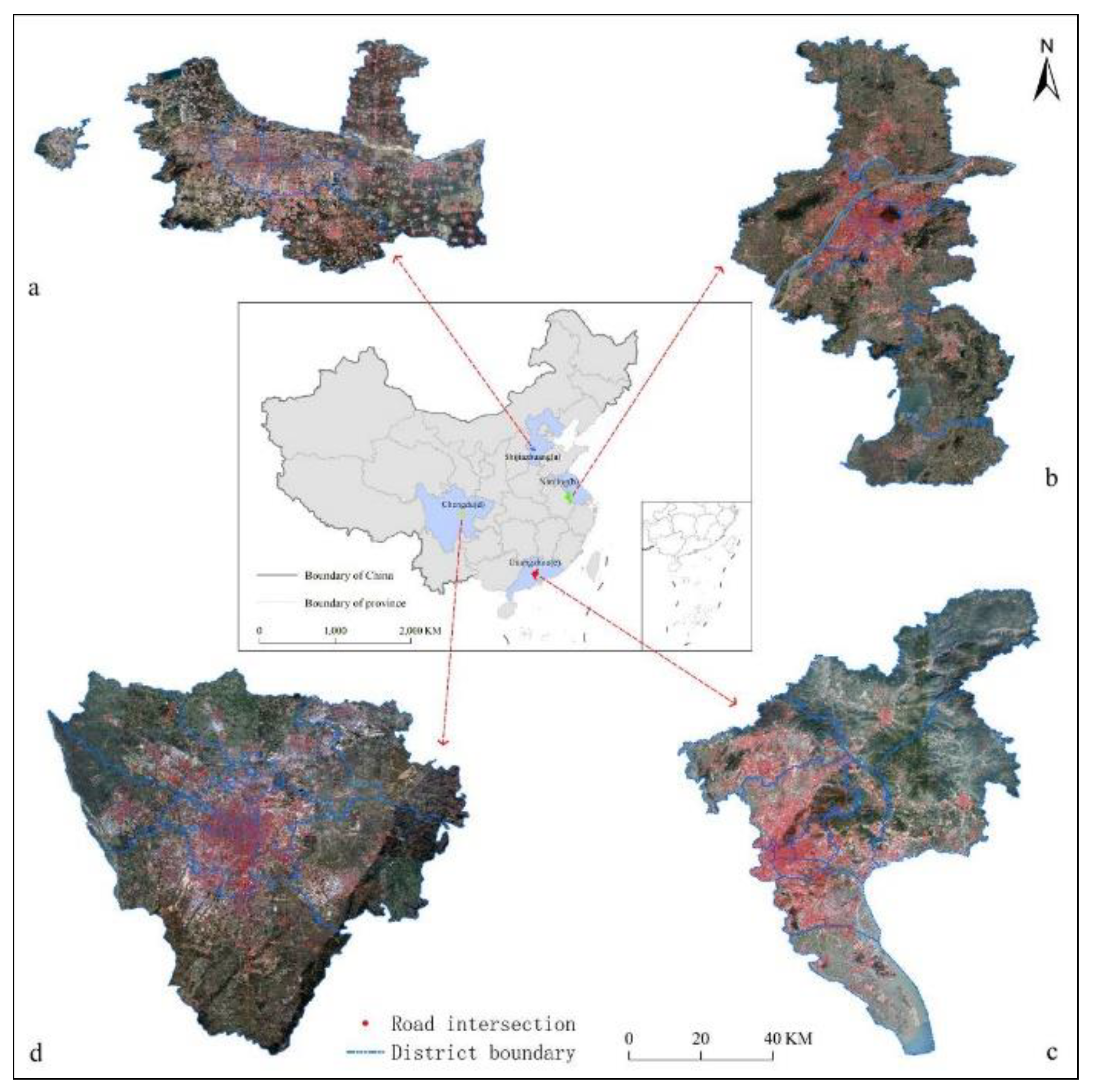
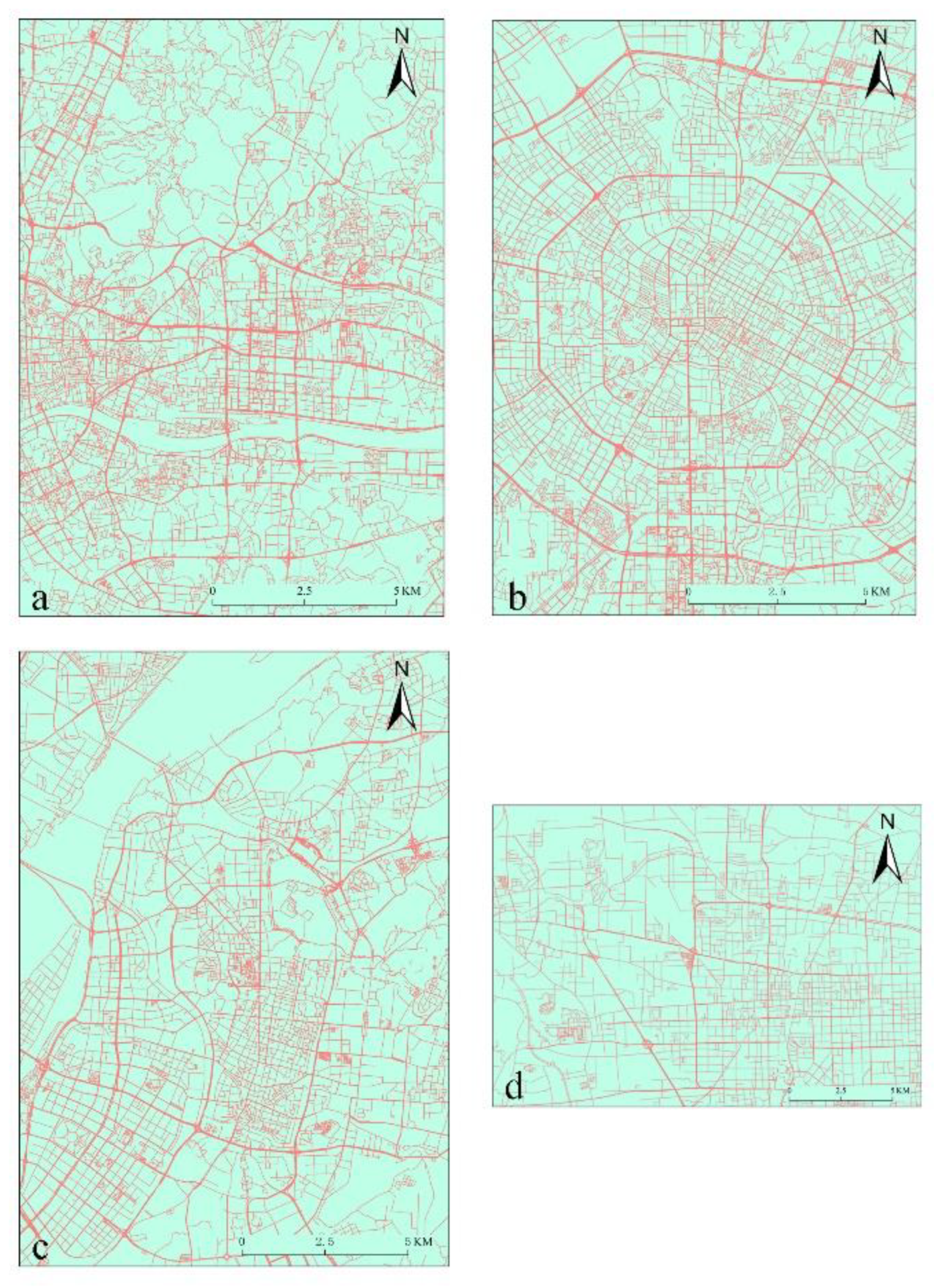
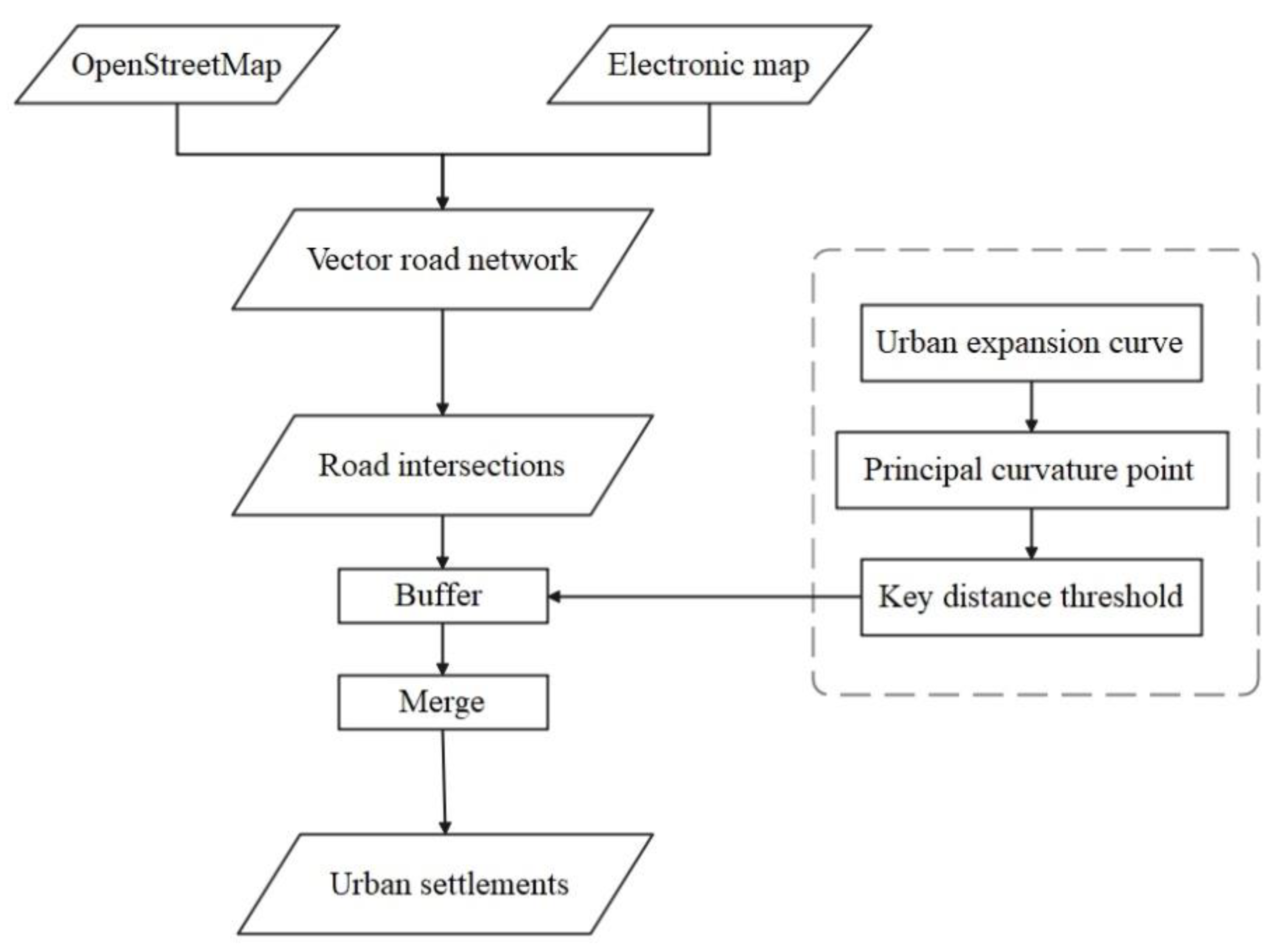

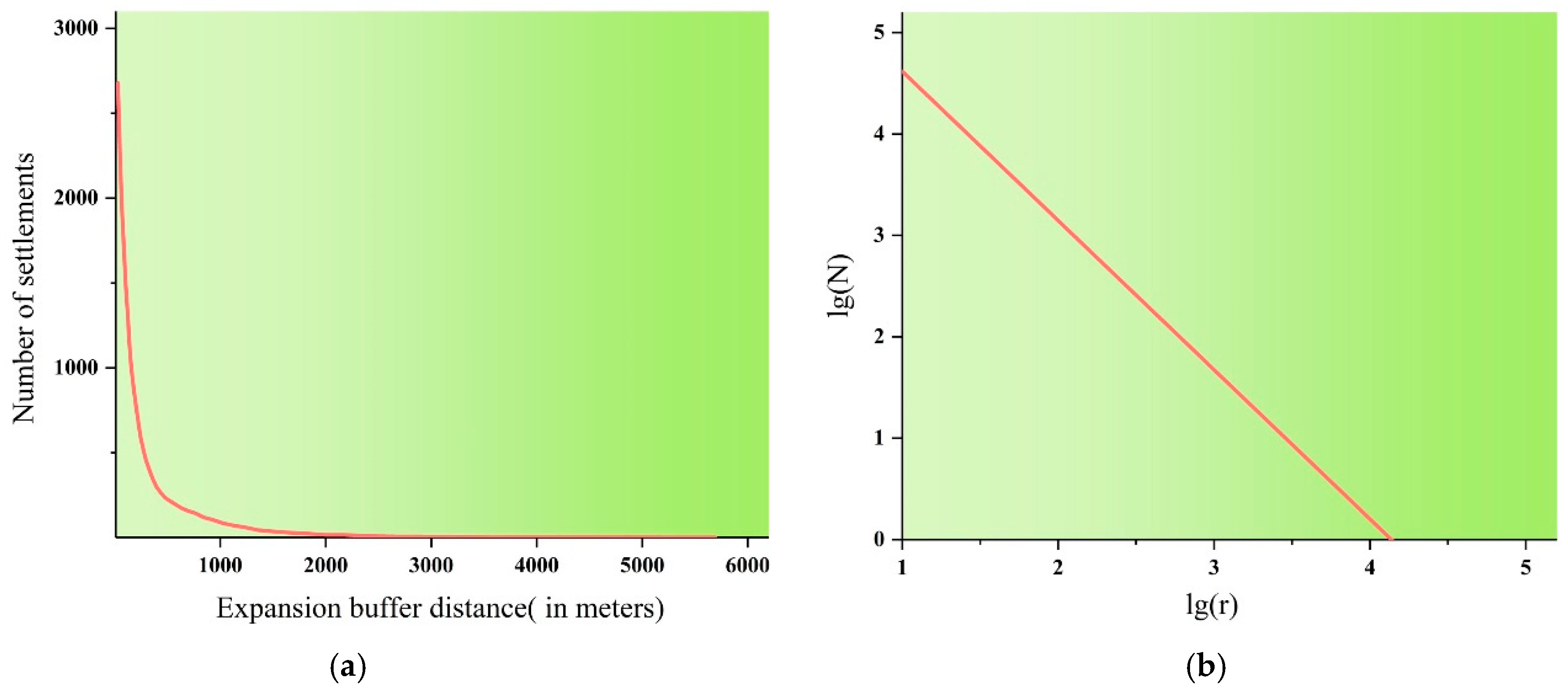
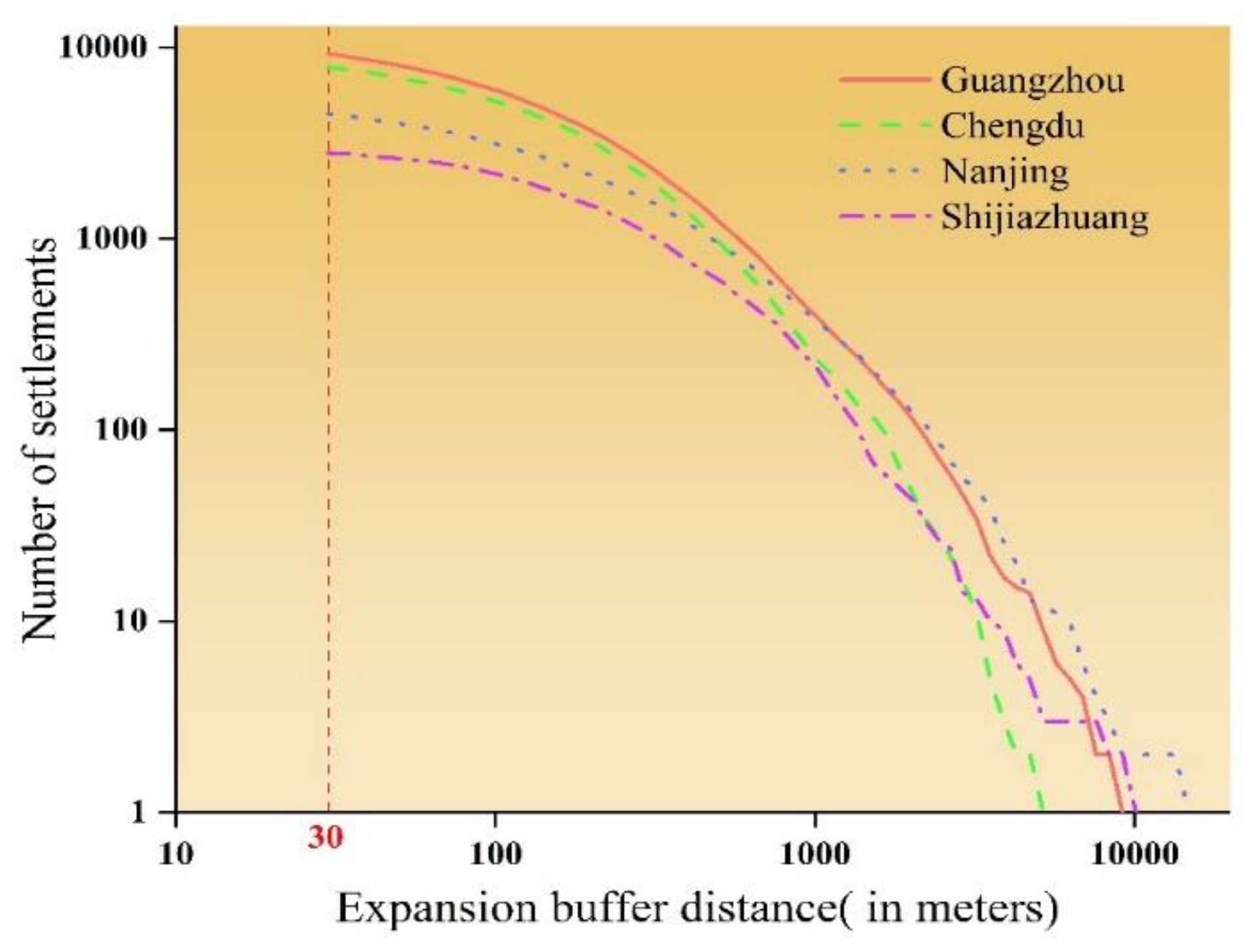
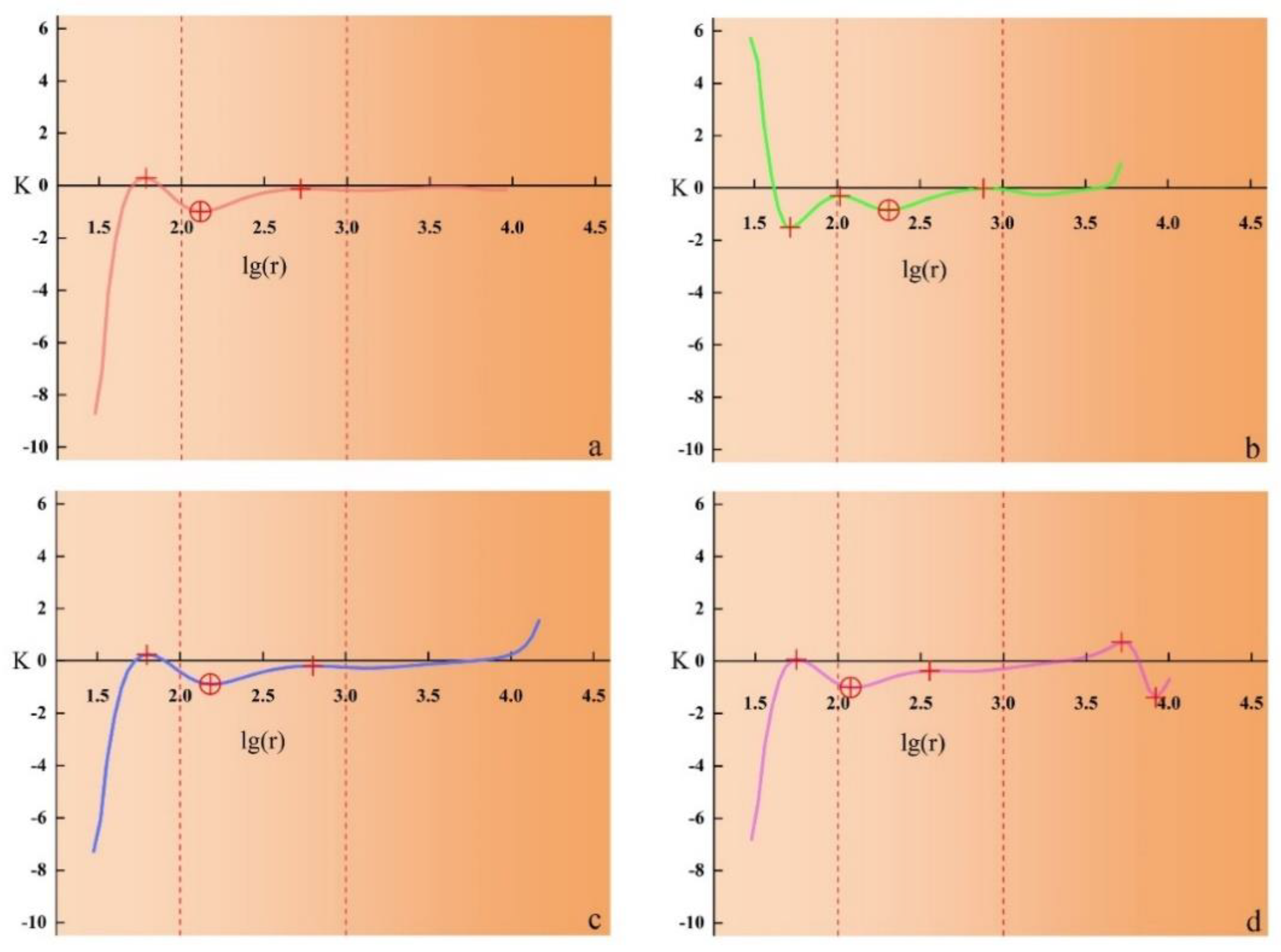
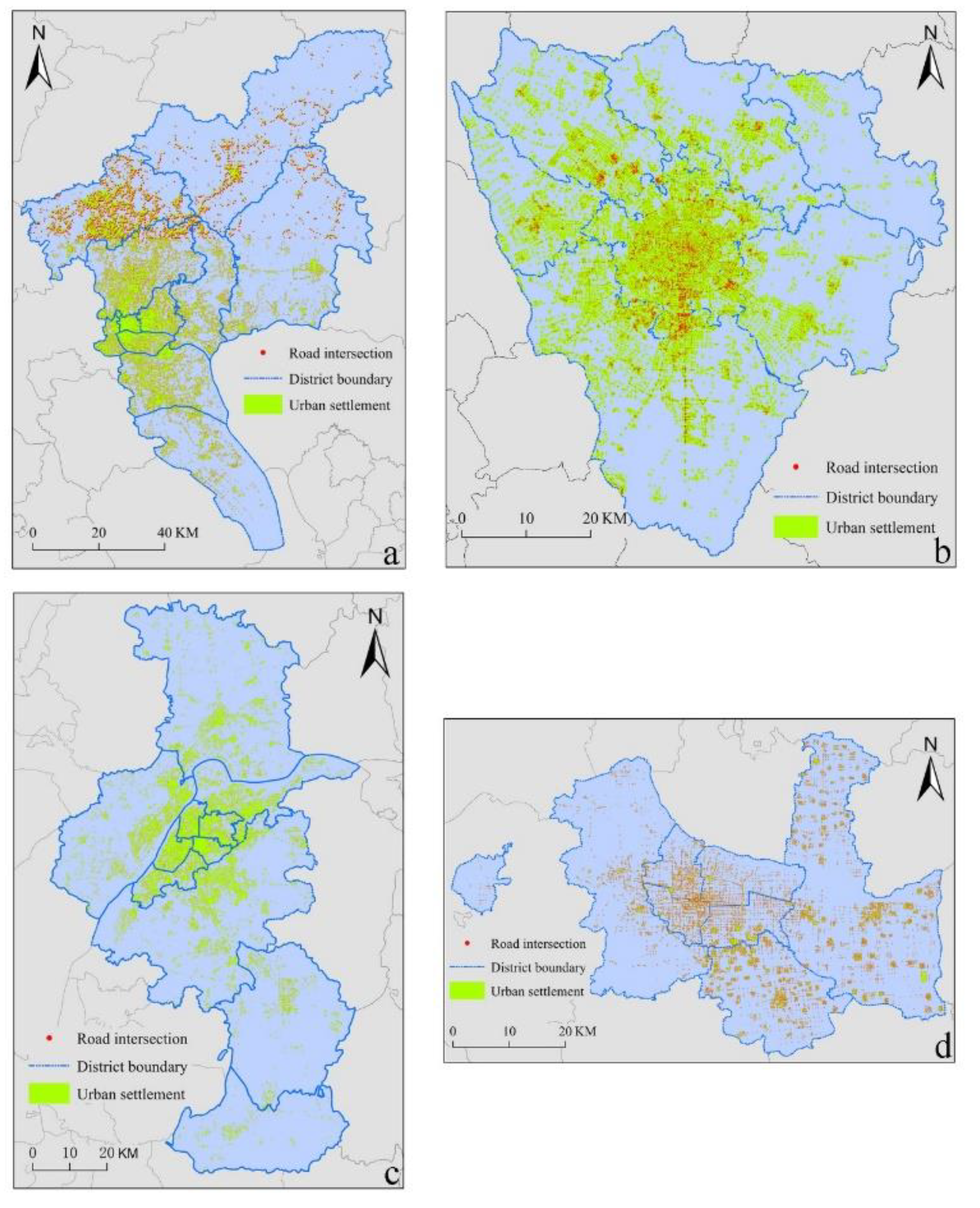
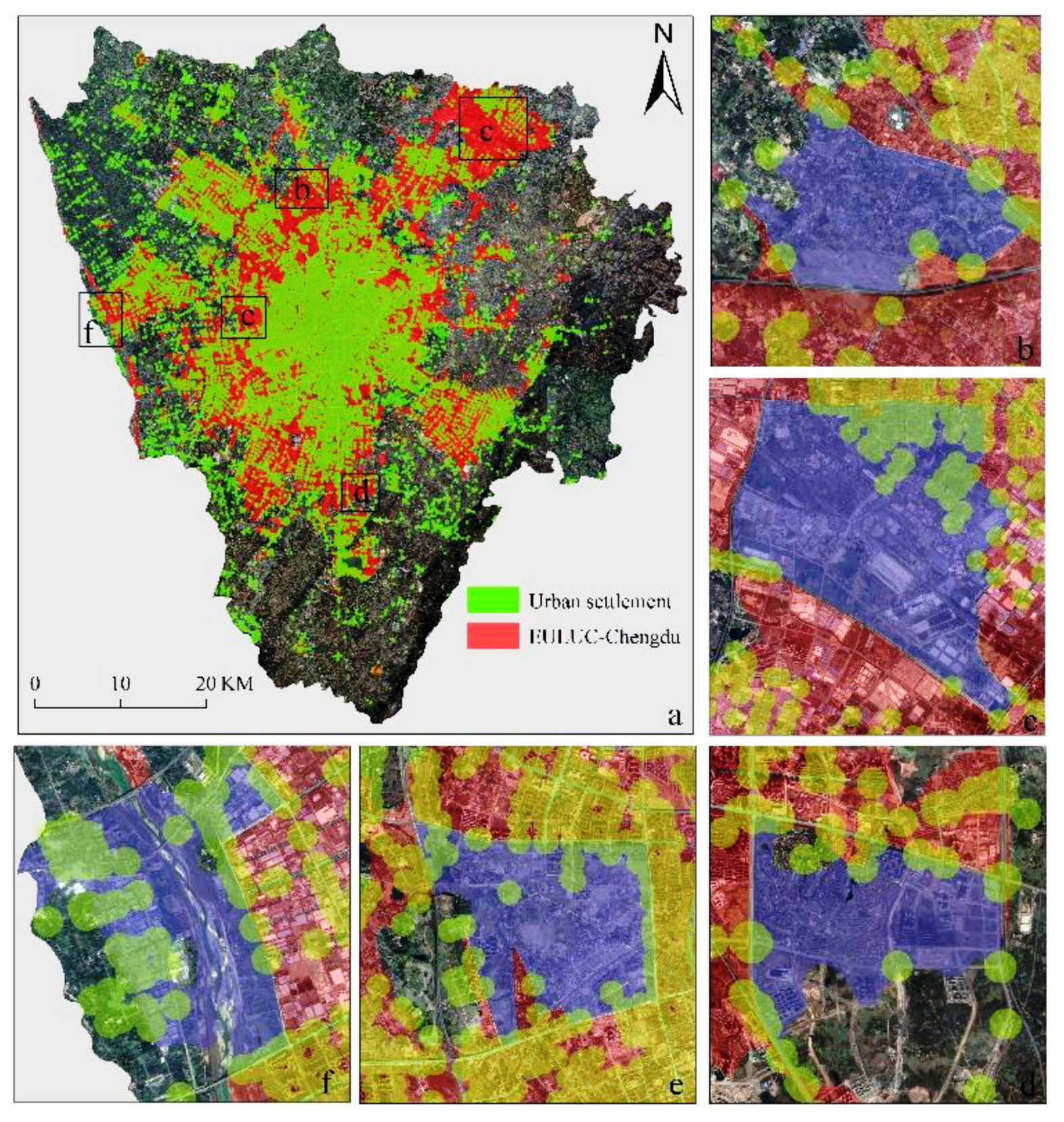
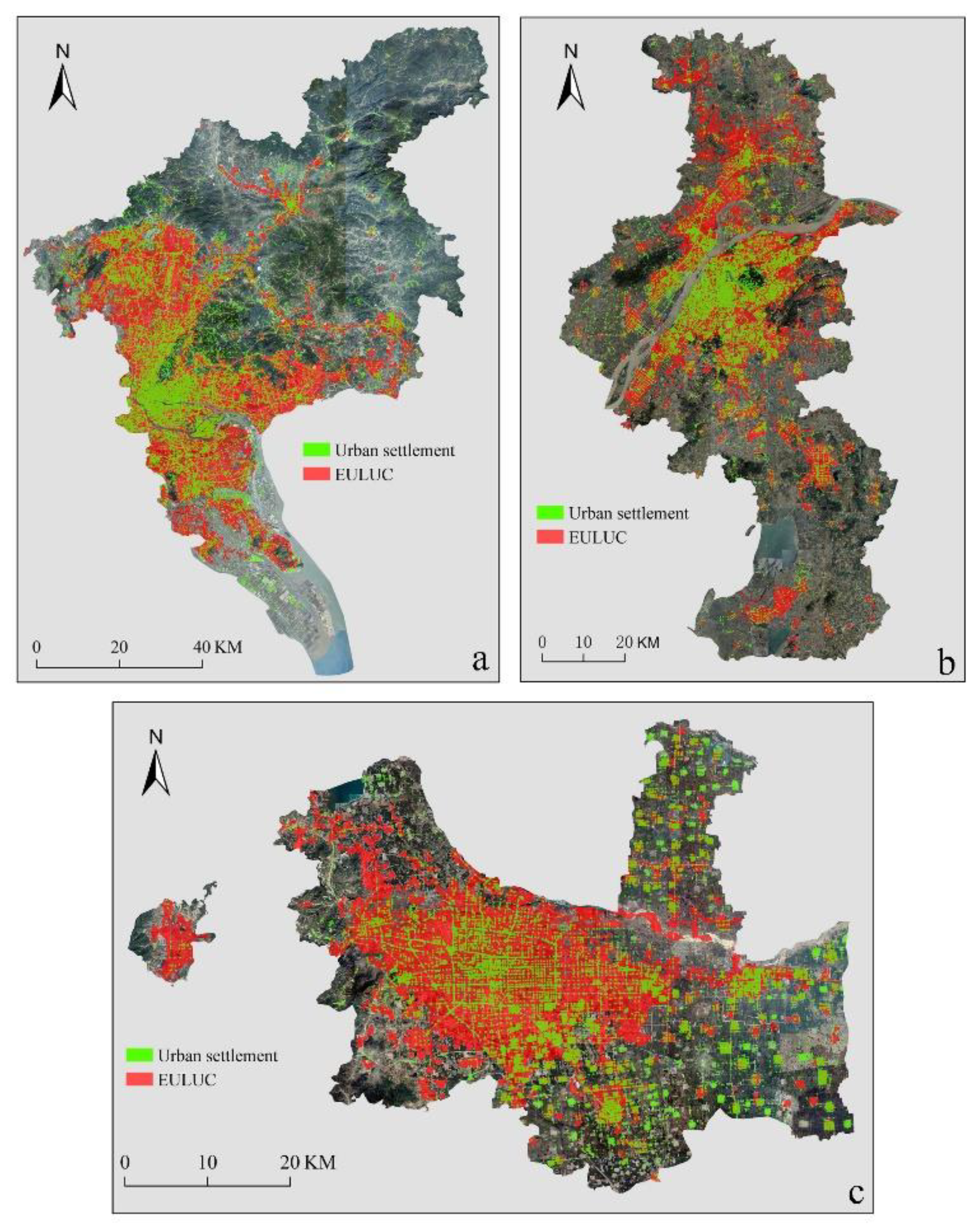
| Expansion Buffer Distance r/m | Number of Urban Settlements/n | Lg(r) | Lg(N) |
|---|---|---|---|
| 30.00 | 9269 | 1.48 | 3.90 |
| 33.00 | 9075 | 1.52 | 3.89 |
| 36.30 | 8848 | 1.56 | 3.88 |
| 39.92 | 8629 | 1.60 | 3.87 |
| 43.92 | 8399 | 1.64 | 3.86 |
| 48.32 | 8148 | 1.68 | 3.85 |
| 53.16 | 7918 | 1.73 | 3.84 |
| 58.48 | 7633 | 1.77 | 3.82 |
| 64.32 | 7358 | 1.81 | 3.80 |
| 70.76 | 7067 | 1.85 | 3.79 |
| 77.84 | 6801 | 1.89 | 3.77 |
| 85.62 | 6463 | 1.93 | 3.75 |
| 94.18 | 6190 | 1.97 | 3.73 |
| 103.60 | 5887 | 2.02 | 3.71 |
| 113.96 | 5551 | 2.06 | 3.69 |
| 125.36 | 5210 | 2.10 | 3.66 |
| 137.90 | 4904 | 2.14 | 3.64 |
| 151.70 | 4574 | 2.18 | 3.61 |
| 166.88 | 4242 | 2.22 | 3.58 |
| 183.56 | 3952 | 2.26 | 3.55 |
| 202.00 | 3643 | 2.31 | 3.51 |
| 222.20 | 3337 | 2.35 | 3.46 |
| 244.40 | 3027 | 2.39 | 3.42 |
| 268.80 | 2737 | 2.43 | 3.37 |
| 295.60 | 2457 | 2.47 | 3.32 |
| 325.20 | 2193 | 2.51 | 3.26 |
| City | Polynomial Fitting Times | R2 |
|---|---|---|
| Guangzhou | 8 | 0.99933 |
| Chengdu | 8 | 0.99904 |
| Nanjing | 8 | 0.99844 |
| Shijiazhuang | 8 | 0.99843 |
| Guangzhou | Chengdu | Nanjing | Shijiazhuang | ||||
|---|---|---|---|---|---|---|---|
| Curvature K | Distance Threshold r/m | Curvature K | Distance Threshold r/m | Curvature K | Distance Threshold r/m | Curvature K | Distance Threshold r/m |
| 0.29 | 60 | −1.51 | 53 | 0.24 | 64 | 0.07 | 57 |
| −0.99 | 132 | −0.31 | 104 | −0.89 | 157 | −1.01 | 124 |
| −0.85 | 204 | ||||||
| −0.12 | 563 | −0.02 | 821 | −0.19 | 633 | −0.37 | 399 |
| 0.73 | 5232 | ||||||
| −1.39 | 8307 | ||||||
| City | Distance Threshold r/m | Urban Settlement Area/km2 | Built-Up Area/km2 | Area Error Rate/% |
|---|---|---|---|---|
| Guangzhou | 60 | 387.17 | 1300.01 | −70.22 |
| 132 | 1099.36 | −15.44 | ||
| 563 | 3776.28 | 190.48 | ||
| Chengdu | 53 | 190.94 | 931.58 | −79.50 |
| 104 | 514.23 | −44.80 | ||
| 204 | 1076.78 | 15.59 | ||
| 821 | 2738.46 | 193.96 | ||
| Nanjing | 64 | 228.19 | 817.39 | −72.08 |
| 157 | 803.07 | −1.75 | ||
| 633 | 2880.69 | 252.43 | ||
| Shijiazhuang | 57 | 116.56 | 309.12 | −62.29 |
| 124 | 353.62 | 14.40 | ||
| 399 | 1181.42 | 282.19 | ||
| 5232 | 3917.91 | 1167.44 | ||
| 8307 | 5013.36 | 1521.82 |
Publisher’s Note: MDPI stays neutral with regard to jurisdictional claims in published maps and institutional affiliations. |
© 2021 by the authors. Licensee MDPI, Basel, Switzerland. This article is an open access article distributed under the terms and conditions of the Creative Commons Attribution (CC BY) license (http://creativecommons.org/licenses/by/4.0/).
Share and Cite
Kong, L.; He, Z.; Chen, Z.; Luo, M.; Du, Z.; Zhu, F.; He, L. Spatial Distribution and Morphological Identification of Regional Urban Settlements Based on Road Intersections. ISPRS Int. J. Geo-Inf. 2021, 10, 201. https://doi.org/10.3390/ijgi10040201
Kong L, He Z, Chen Z, Luo M, Du Z, Zhu F, He L. Spatial Distribution and Morphological Identification of Regional Urban Settlements Based on Road Intersections. ISPRS International Journal of Geo-Information. 2021; 10(4):201. https://doi.org/10.3390/ijgi10040201
Chicago/Turabian StyleKong, Liang, Zhengwei He, Zhongsheng Chen, Mingliang Luo, Zhong Du, Fuquan Zhu, and Li He. 2021. "Spatial Distribution and Morphological Identification of Regional Urban Settlements Based on Road Intersections" ISPRS International Journal of Geo-Information 10, no. 4: 201. https://doi.org/10.3390/ijgi10040201
APA StyleKong, L., He, Z., Chen, Z., Luo, M., Du, Z., Zhu, F., & He, L. (2021). Spatial Distribution and Morphological Identification of Regional Urban Settlements Based on Road Intersections. ISPRS International Journal of Geo-Information, 10(4), 201. https://doi.org/10.3390/ijgi10040201








